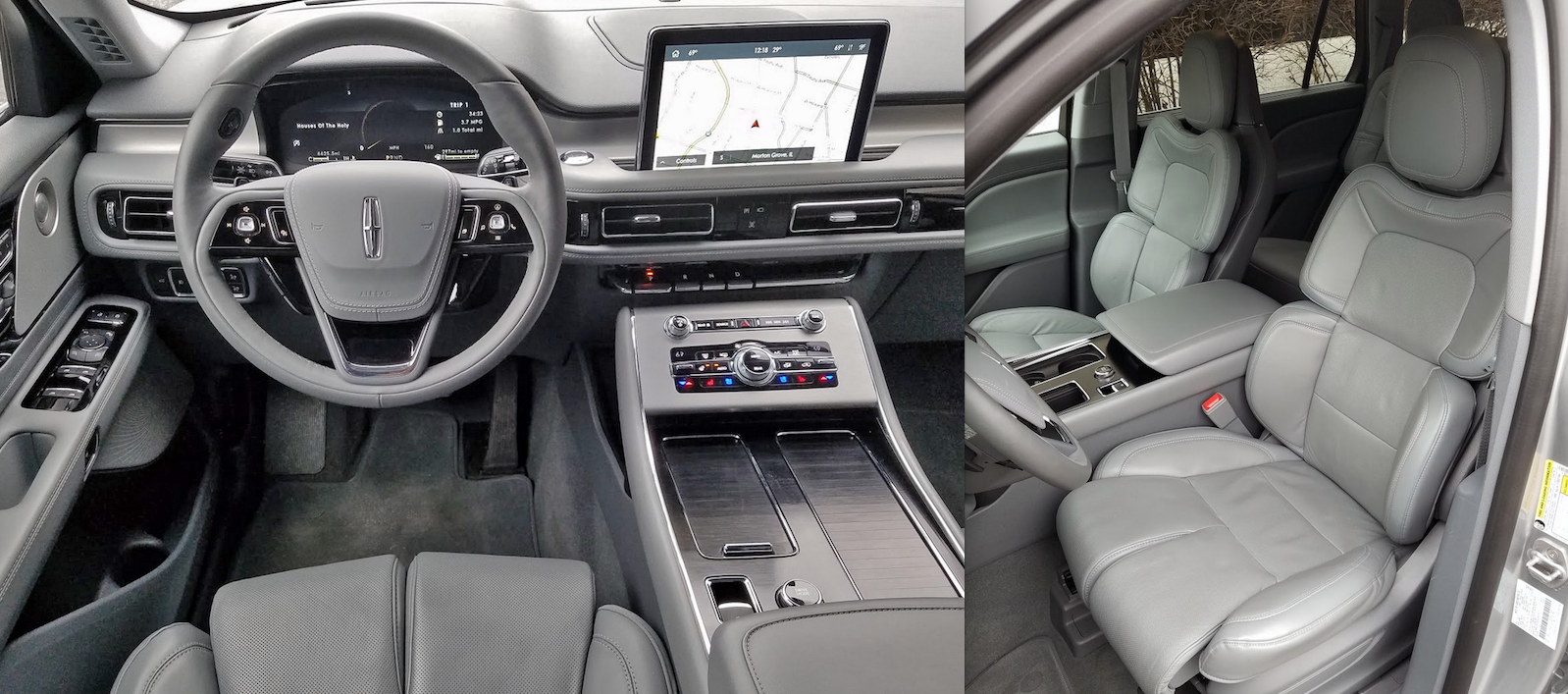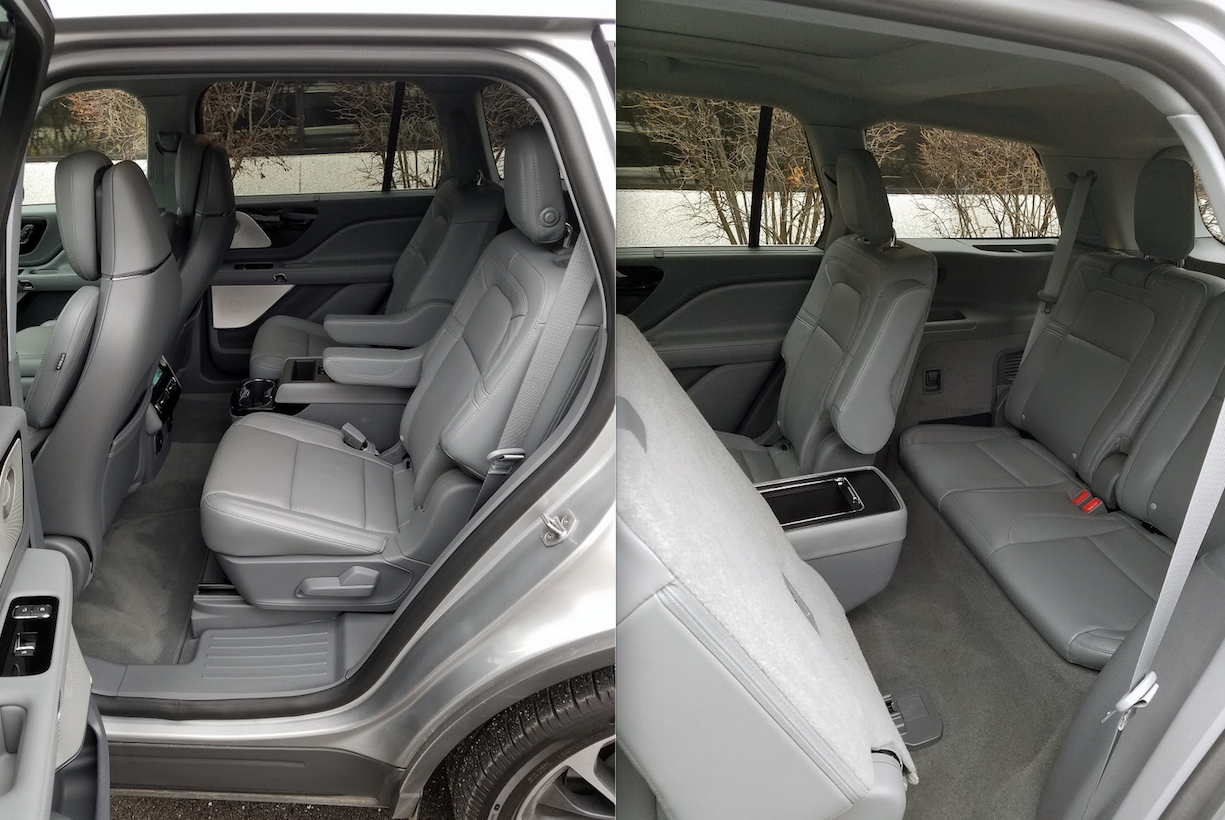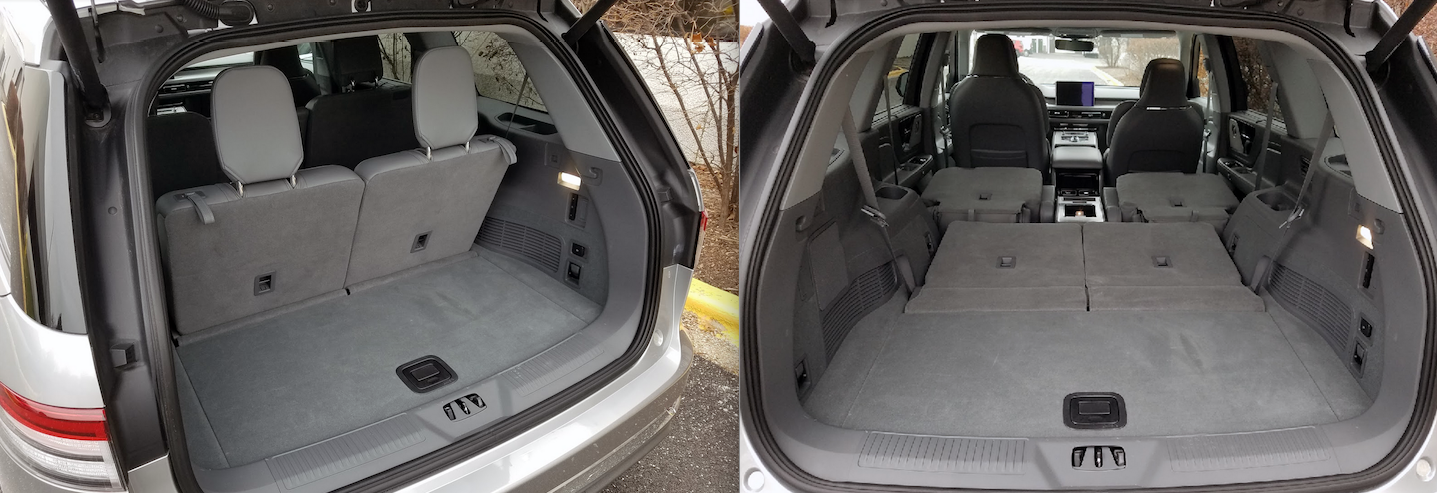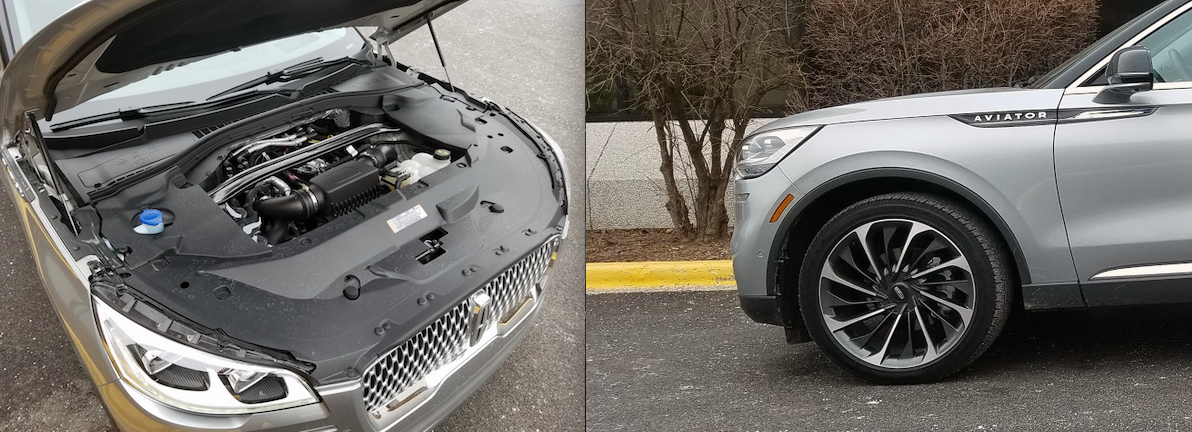
2020 Lincoln Aviator Reserve AWD
Class: Premium Midsize Crossover SUV
Miles driven: 343
Fuel used: 21.2 gallons
| CG Report Card | |
|---|---|
| Room and Comfort | B+ |
| Power and Performance | B+ |
| Fit and Finish | A- |
| Fuel Economy | C |
| Value | B- |
| Report-card grades are derived from a consensus of test-driver evaluations. All grades are versus other vehicles in the same class. Value grade is for specific trim level evaluated, and may not reflect Consumer Guide's impressions of the entire model lineup. | |
| Big & Tall Comfort | |
| Big Guy | A |
| Tall Guy | A |
| Big & Tall comfort ratings are for front seats only. "Big" rating based on male tester weighing approximately 350 pounds, "Tall" rating based on 6'6"-tall male tester. | |
| Drivetrain | |
| Engine Specs | 400-hp 3.0-liter |
| Engine Type | twin-turbo V6 |
| Transmission | 10-speed automatic |
| Drive Wheels | AWD |
Real-world fuel economy: 16.1
Driving mix: 70% city, 30% highway
EPA-estimated fuel economy: 17/24/20 (city, highway, combined)
Fuel type: Regular gas
Base price: $58,700 (not including $1095 destination charge)
Options on test vehicle: Equipment Group 202A ($10,125), Convenience Package ($3390), Dynamic Handling Package ($3000) Full Rear Console (no charge)
Price as tested: $76,310
Quick Hits
The great: Robust acceleration; lavishly finished interior
The good: Lots of advanced comfort and convenience features; distinctive luxury personality
The not so good: Mediocre fuel economy; steep pricing; driver’s seating position feels odd to some testers
More Aviator price and availability information
John Biel
It’s not entirely fair—or correct—to dismiss one of the new nameplates in the expanding Lincoln SUV universe as a deluxe Ford Explorer. At the same time, it’s accurate to point out that the premium-midsize 3-row Aviator springs from the same stock, which is completely redone for 2020.

The Aviator steps in for the MKT, one of Lincoln’s several alphabetical models from the 2010s. It has the same new longitudinal engine alignment and rear-drive-based driveline—when not equipped with all-wheel drive—as the ’20 Explorer. They share a 10-speed automatic transmission and one V6 engine, to say nothing of certain corporate safety and infotainment features. Wisely, though, Ford Motor Company chiefs have opened many points of departure between the Explorer and the Aviator.
Quick Spin: 2020 Nissan Armada Platinum

Aviators come in three gas-engine trim levels and two ranks of plug-in gas/electric hybrid. Consumer Guide tested a Reserve, which sits at the center of the gas-engine group. It was equipped with all-wheel drive, a $2510 upcharge from the same vehicle with rear-wheel drive.
The sole gas powerplant is a twin-turbocharged 3.0-liter V6 of 400 horsepower and 415 lb-ft of torque. In the Explorer, this engine is the most powerful one available, and is only found in the high-performance ST model. In the Aviator, however, it’s just the starting point—the same engine teamed with an electric motor makes 494 horsepower and 630 lb-ft in the plug-in hybrids.
Test Drive: 2020 Ford Explorer ST

The 3.0-liter behaves about the same in the Aviator as it does in the Explorer ST, with the exception that the luxury-oriented Lincoln tones down the exhaust report. In “Excite” mode, one of several driving and surface-management settings available at a twist of a dial on the console, throttle response is immediate. Transmission shifts are delayed, and the engine pulls with persistent strength toward each successive upshift. Indeed, the process feels less choppy than the shorter-spaced shifts in “Normal” mode. However, it doesn’t require Excite to experience free and easy highway cruising, and prompt trans kickdown delivers confident passing power.
EPA fuel-economy estimates for AWD gas-engine Aviators are 17 mpg in the city, 24 mpg in highway operation, and 20 combined. This reviewer posted just 15.0 mpg after a test stint of 172 miles, 70 percent of which was in city-style driving—and that was about two mpg worse than he got from an Explorer ST with the same engine and driveline, albeit with more highway driving.
Test Drive: 2020 Cadillac XT6 Premium Luxury

Chassis tuning emphasizes comfort. An adaptive suspension comes standard, and the Dynamic Handling Package option added to CG’s Silver Radiance Metallic test truck includes “Road Preview” that uses a camera to read the road surface ahead and transmit an advance warning of sorts to the suspension so that it can adjust appropriately. Also available is “Air Glide,” which replaces coil springs with air bladders that soften the ride and permit the Aviator to lower itself for easier entry and exit or raise and lower itself to address specific driving conditions. In Excite mode, ride firms up, but remains quite pleasant, and handling and steering get somewhat sharper.
The Aviator Reserve comes standard with widely used FoMoCo tech like the Sync3 infotainment system with voice-activated navigation and the Co-Pilot 360 system of driving aids (forward-collision warning with automatic emergency braking, lane-keep assist, and blind-spot and rear cross-traffic alerts). However, as we suggested at the start, it is not just an Explorer with a Lincoln grille and quieter exhaust. The Aviator is its own vehicle in many important ways.

One difference in the Lincoln is a seating position that, frankly, felt odd to this driver—high, and close to the steering wheel, which seemed low when properly adjusted to his grip. This perception might have something to do with the Aviator’s linear, highly stylized instrument-panel design. Where the Explorer uses a rotating dial to shift the transmission, the Aviator has four keys tucked between the bottom of the dash and the console. Expect some period of acclimation before being able to flick from Reverse to Drive as dexterously as with a traditional upright lever. The leather-upholstered part of the front seats appears to float out of a hard-backed shell to which power adjustable headrests are connected. Also, though the Aviator and Explorer measure out nearly identically, the Ford has more cargo space—up to 10.1 cubic feet more from behind the front seats.
Comfort on those arty front seats trends more acceptable than exceptional. The Reserve’s standard second-row captain’s chairs are cushy, yet supportive. Two third-row seats are best suited for kids—even this hardly towering test driver had extremely limited knees-up legroom when he squeezed in. Middle seats track forward to assist back-row entry and exit, but the optional full-height second-row console on CG’s tester prevented easy pass-through. There’s good headroom and legroom in the front two rows. Step-in height isn’t particularly challenging, but over-the-shoulder driver vision is limited by the thickness of the roof pillars.
Test Drive: 2020 Hyundai Palisade Limited

The cabin has abundant soft-touch surfaces. A colorful electronic instrument display changes with the drive modes. Audio presets are input directly on the 10.1-inch touchscreen; a tuning knob on the console makes it easy to select them in the first place. Four-zone climate controls and front seat heating/cooling controls are handled by a cluster of buttons and repetitive-push temperature levers, but a large central dial governs fan speed. A thumb button on the upper-left quadrant of the steering wheel activates voice command, but it’s as easy to tap accidentally as intentionally.
Front-row personal-item storage is marshalled by a generous glove box and lighted console box. One covered bin in the console holds device inputs and a wireless charger. Another houses two cup holders. The second row has exposed cup holders and a deep covered bin in the optional console. Hard-sided pouches are on the back of each front seat. Cup holders and storage trays are molded into the sidewalls of the third row. Cargo space, modest with all seats up, benefits from bonus room under the floor panel. Power-folding rear 50/50 seats rest flat to extend load space. Folded second-row seats leave a gap behind, and the console will have to be negotiated when loading long objects.
The all-wheel-drive Aviator Reserve starts at $59,795 with delivery, but CG’s amply equipped test truck hit $76,310—and that’s hardly this flyboy’s ceiling. It is a better entry in the luxury-midsize field than Lincoln had before.

Listen to the Consumer Guide Car Stuff Podcast
2020 Lincoln Aviator Reserve



